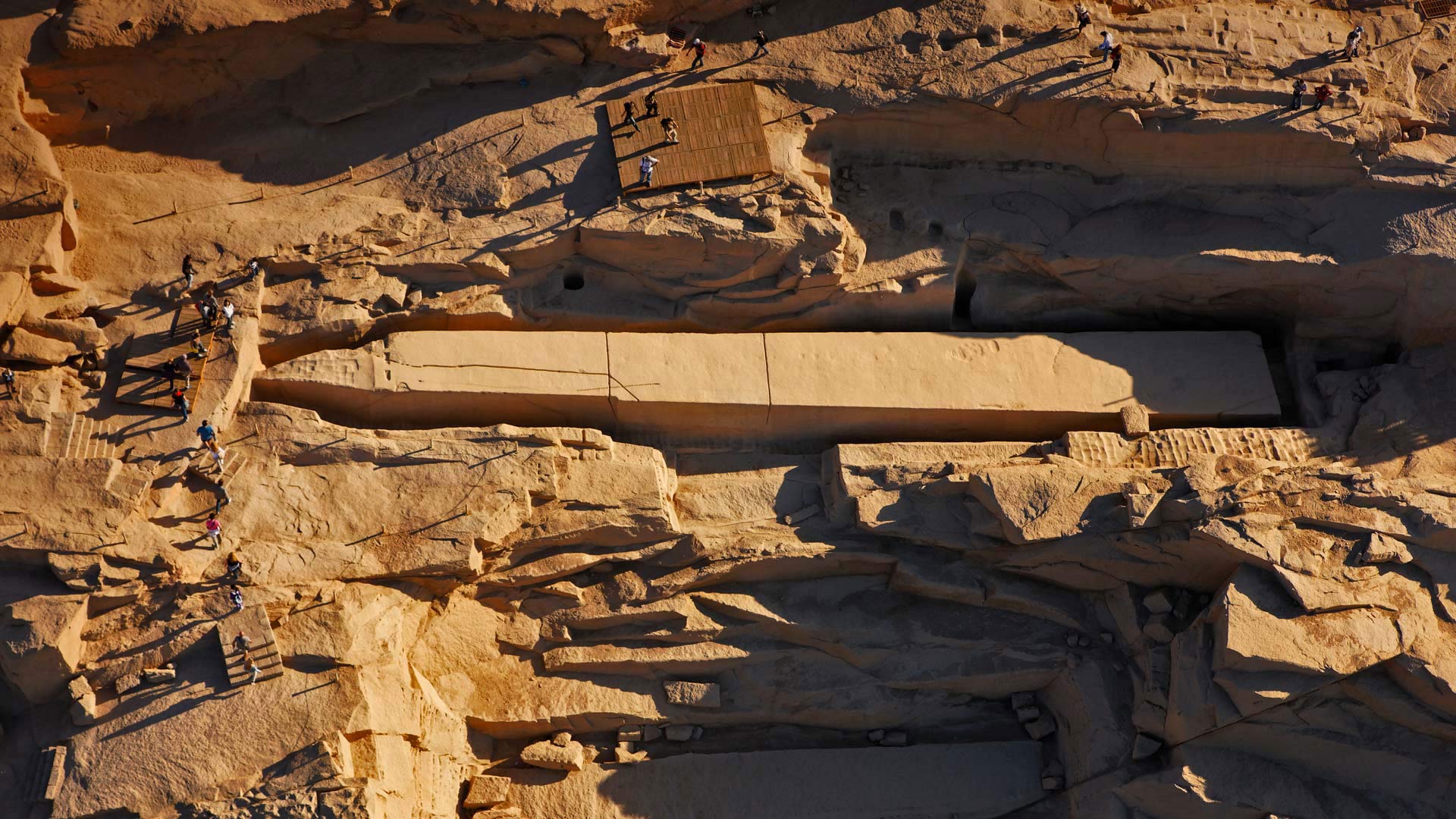标签 埃及 下的文章
哈索尔神庙,邓德拉神庙群,基纳,埃及 Temple of Hathor, Dendera Temple Complex, Qena, Egypt (© Nick Brundle Photography/Getty Images)
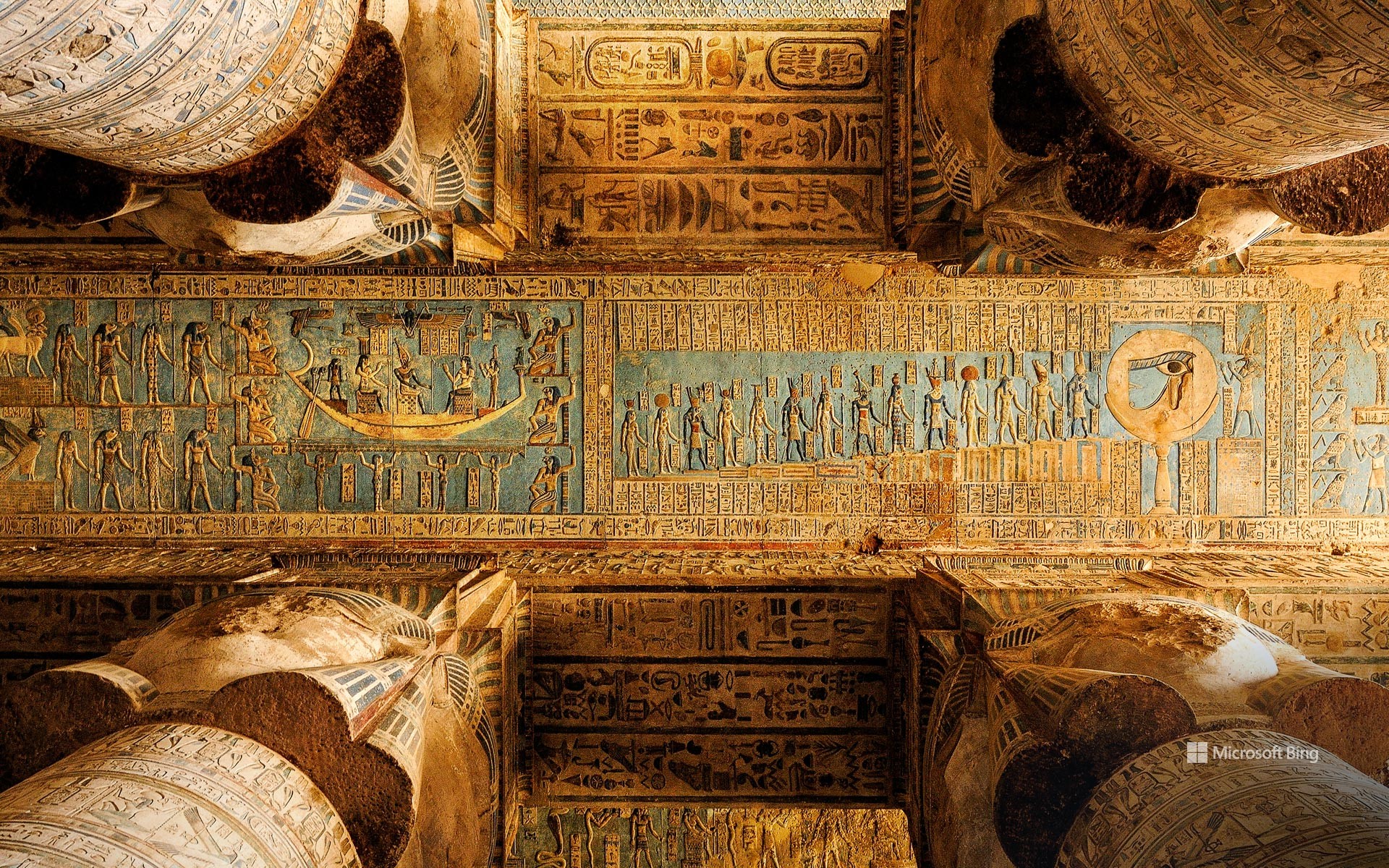
哈索尔神庙,邓德拉神庙群,基纳,埃及 Temple of Hathor, Dendera Temple Complex, Qena, Egypt (© Nick Brundle Photography/Getty Images)
立足现在,发掘过去 Uncovering the past for the present
国际考古日
今天,在国际考古日,深入挖掘你内心的印第安纳·琼斯或劳拉·克劳馥吧!该节日始于2011年,于每年10月的第三个星期六举办庆祝活动,旨在庆祝考古学对当今社会做出的贡献。其全球性的活动包括举办展览和动手挖掘遗迹,有些活动还会持续一个月。此外,许多美国国家公园、州立公园、历史地标和当地博物馆也会举办相关活动。
埃及是较早开展国际考古日活动的国家之一,从今天的图片中可以看到埃及哈索尔神庙的天花板。哈索尔神庙是丹德拉神庙群的一部分,也是保存最完好的古埃及神庙之一。虽然目前的神庙可以追溯到托勒密十二世和克利奥帕特拉七世(约公元前 50 年),但有证据表明,以前供奉埃及爱情和生育女神哈索尔的神庙可以追溯到数千年前。
International Archaeology Day
Today, dig deep and unearth your inner Indiana Jones or Lara Croft on International Archaeology Day. The event celebrates archaeology's benefits for society, and includes exhibits and hands-on excavations, some of which run throughout the month. Many US national and state parks, historic landmarks, and local museums also hold events.
Egypt is steeped in ancient history and home to many internationally renowned archaeological sites, including the Temple of Hathor, the ceiling of which can be seen in today's image. Part of the Dendera Temple Complex in Qena, Hathor is one of the best-preserved ancient Egyptian temples. While the current temple dates to Ptolemy XII and Cleopatra VII (around 50 BCE), evidence suggests that previous temples dedicated to Hathor, an Egyptian goddess of love and fertility, go back thousands of years earlier.
白沙漠中的岩石,埃及 Rock formations in the White Desert, Egypt (© Anton Petrus/Getty Images)
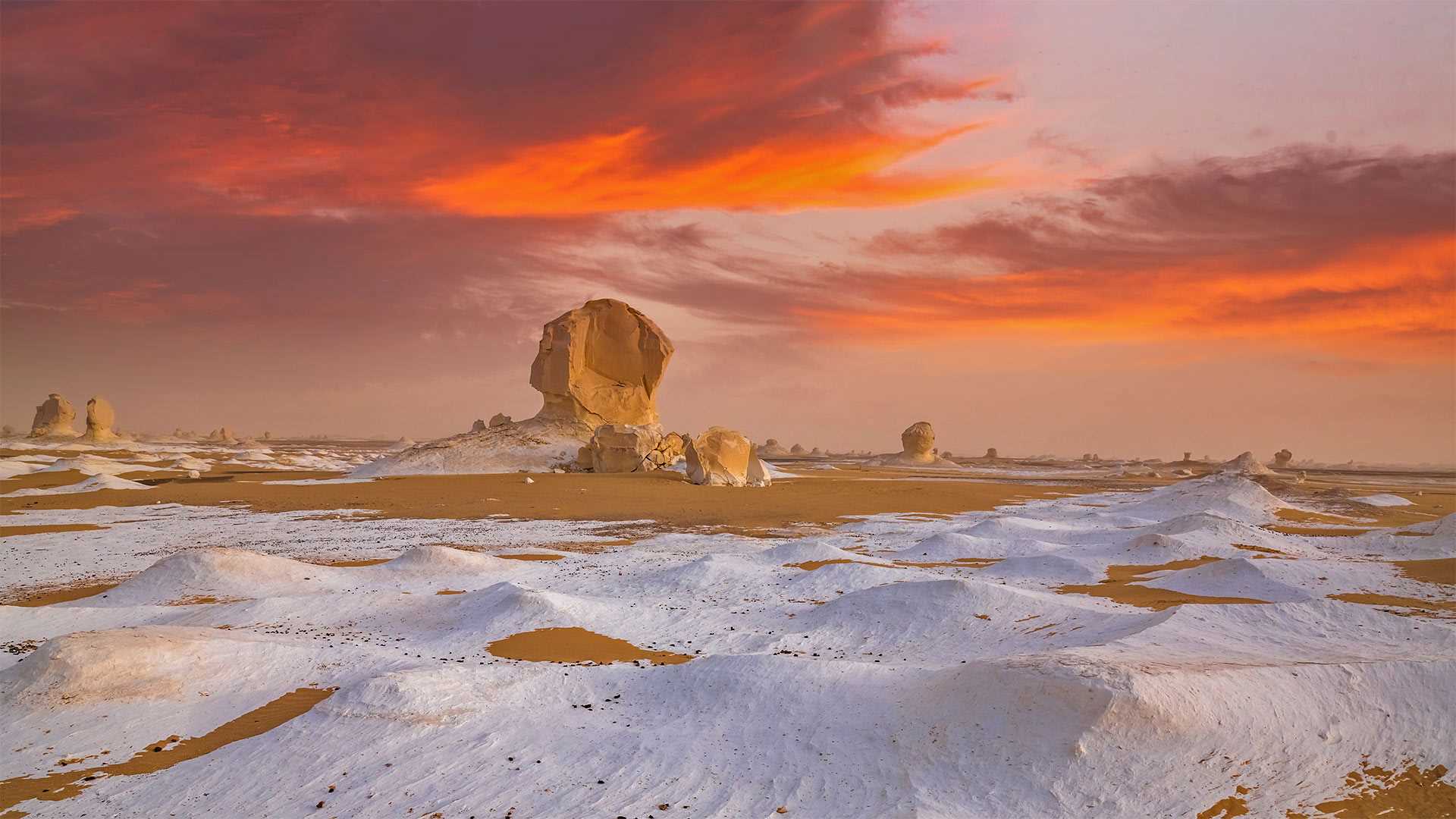
白沙漠中的岩石,埃及 Rock formations in the White Desert, Egypt (© Anton Petrus/Getty Images)
这些雪永远不会融化 This snow will never melt
白沙漠国家公园,埃及
这是沙漠中的雪吗?其实不是。这里是埃及的白沙漠,当地丰富的白垩岩、石灰岩、石英岩以及长年累月的风化作用造就了这些白色的沙子和形状奇特的岩石,白沙漠也因此得名。游客们蜂拥而至,来欣赏这些大自然的奇观。白沙国家公园距离开罗约5小时车程,这里不仅有白沙和怪石,还有多种濒危保护动物。
White Desert National Park, Egypt
Snow, in the desert? Not quite. Today we're in Egypt's White Desert, which gets its colorful name from an abundance of chalk, limestone, and quartz rock formations that give the sand its special hue. Tourists flock to this place to see these naturally occurring structures, honed over thousands of years into unique shapes through a process known as 'differential weathering.' Located about five hours to the southwest of Cairo, White Desert National Park is a lot more than just deteriorating rocks—it's also a protected refuge for several endangered animal species.
埃及博物馆图坦卡蒙墓中的神像描绘, 埃及开罗 Depiction of deities from the Tomb of Tutankhamun at the Egyptian Museum, Cairo, Egypt (© Stefan Lippmann/Universal Images Group via Getty Images)
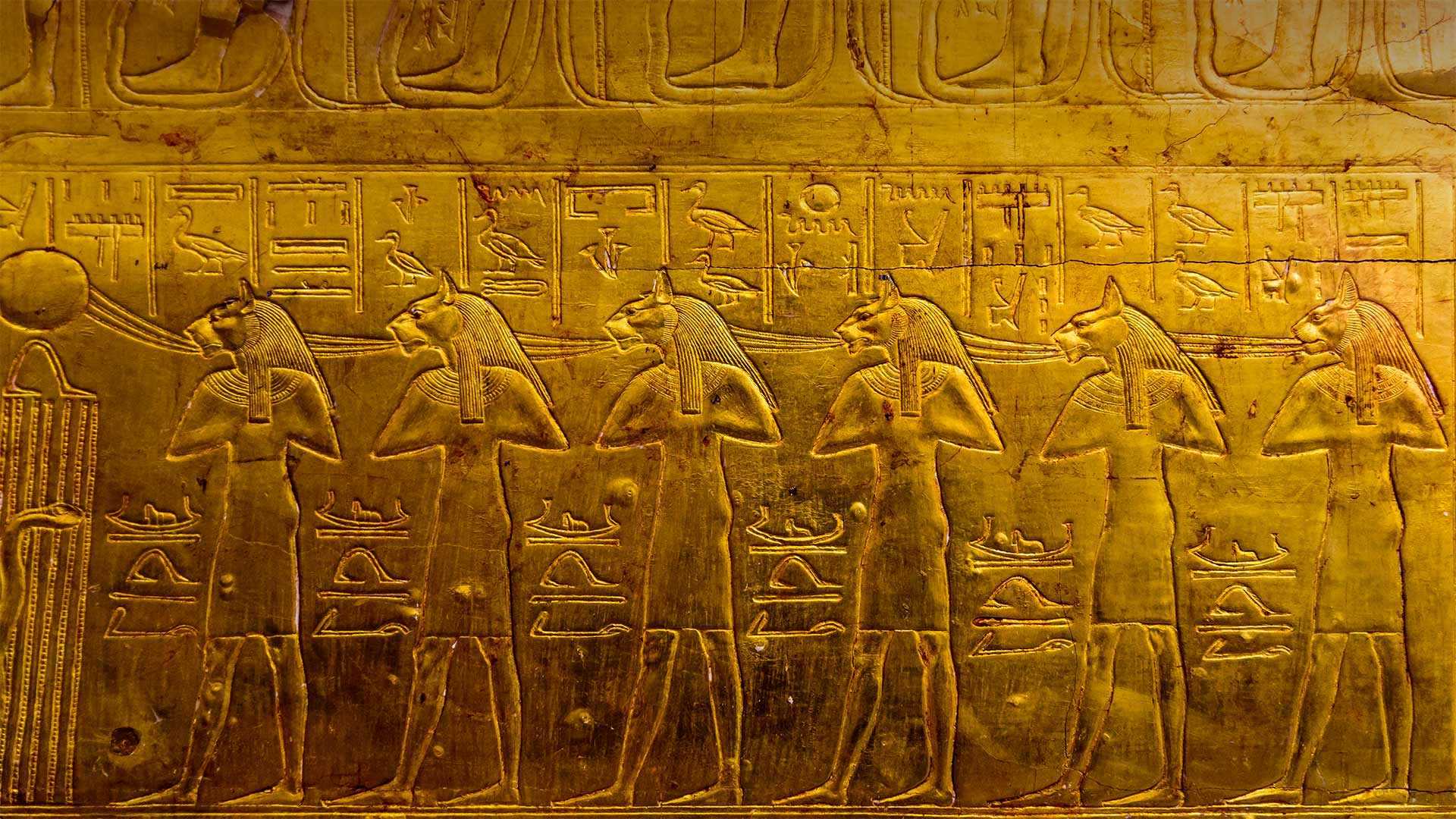
埃及博物馆图坦卡蒙墓中的神像描绘, 埃及开罗 Depiction of deities from the Tomb of Tutankhamun at the Egyptian Museum, Cairo, Egypt (© Stefan Lippmann/Universal Images Group via Getty Images)
金色法老之墓 Tomb of the Golden Pharaoh
图坦卡蒙墓被发现一个世纪以来
一百年前的今天,英国考古学家和埃及学家霍华德·卡特在埃及国王谷发现了图坦卡蒙的石棺,也就是人们熟知的图坦卡门国王。尽管他们在1922年11月4日首次发现了“男孩国王”的陵墓,卡特和船员们花了数年时间才挖掘出墓地。他们的发现令世界震惊。它装载了超过5389件文物,包括一个纯金棺材、面罩、王座、弓箭、号角、一个莲花圣杯、家具、食物、酒、凉鞋、保护图坦卡蒙脚趾的金帽和新鲜亚麻内衣。因为你应该总是带着干净的内衣,即使你穿越到杜阿特,死亡的王国。
尽管图坦卡蒙被历史学家认为是一位未成年的法老,但他的陵墓的发现却是考古学史上最重要的发现之一。与许多邻近的墓葬不同,该墓地保存得非常完好,由于大部分墓葬的入口都覆盖着残骸,盗墓者都没有触及过该墓地。20世纪60年代,埃及允许图坦卡蒙国王的珍宝离开埃及展出,该展览已多次走遍世界。今天,图坦卡蒙国王的死亡面具和石棺在开罗埃及博物馆展出。
A century since Tut's tomb was discovered
A hundred years ago today, British archaeologist and Egyptologist Howard Carter discovered the sarcophagus of Tutankhamun, better known as King Tut, in Egypt's Valley of Kings. Though they first uncovered the tomb of the 'boy king' on November 4, 1922, Carter and crew took years to excavate the burial site. What they found astonished the world. It was loaded with more than 5,389 artifacts, including a solid gold coffin, face mask, thrones, archery bows, trumpets, a lotus chalice, furniture, food, wine, sandals, gold caps to protect Tut's toes, and fresh linen underwear. Because you should always bring clean undies, even when you're crossing into Duat, the realm of the dead.
Though Tut is considered a minor pharaoh by historians, the discovery of his tomb was one of the most significant in the history of archaeology. The burial site was remarkably well preserved—unlike many neighboring tombs, it was untouched by grave robbers thanks to debris covering the entrance for most of the tomb's existence. In the 1960s, Egypt allowed the treasures of King Tut to leave the country for display, and the exhibit has traveled the world numerous times. Today, King Tut's death mask and sarcophagus are displayed here at the Egyptian Museum in Cairo.
Jean Rene创作的《吉萨的问候》, 埃及开罗 'Greetings From Giza' by Jean Rene, in Cairo, Egypt (© Ammar ABD RABBO/Abaca Press/Alamy)
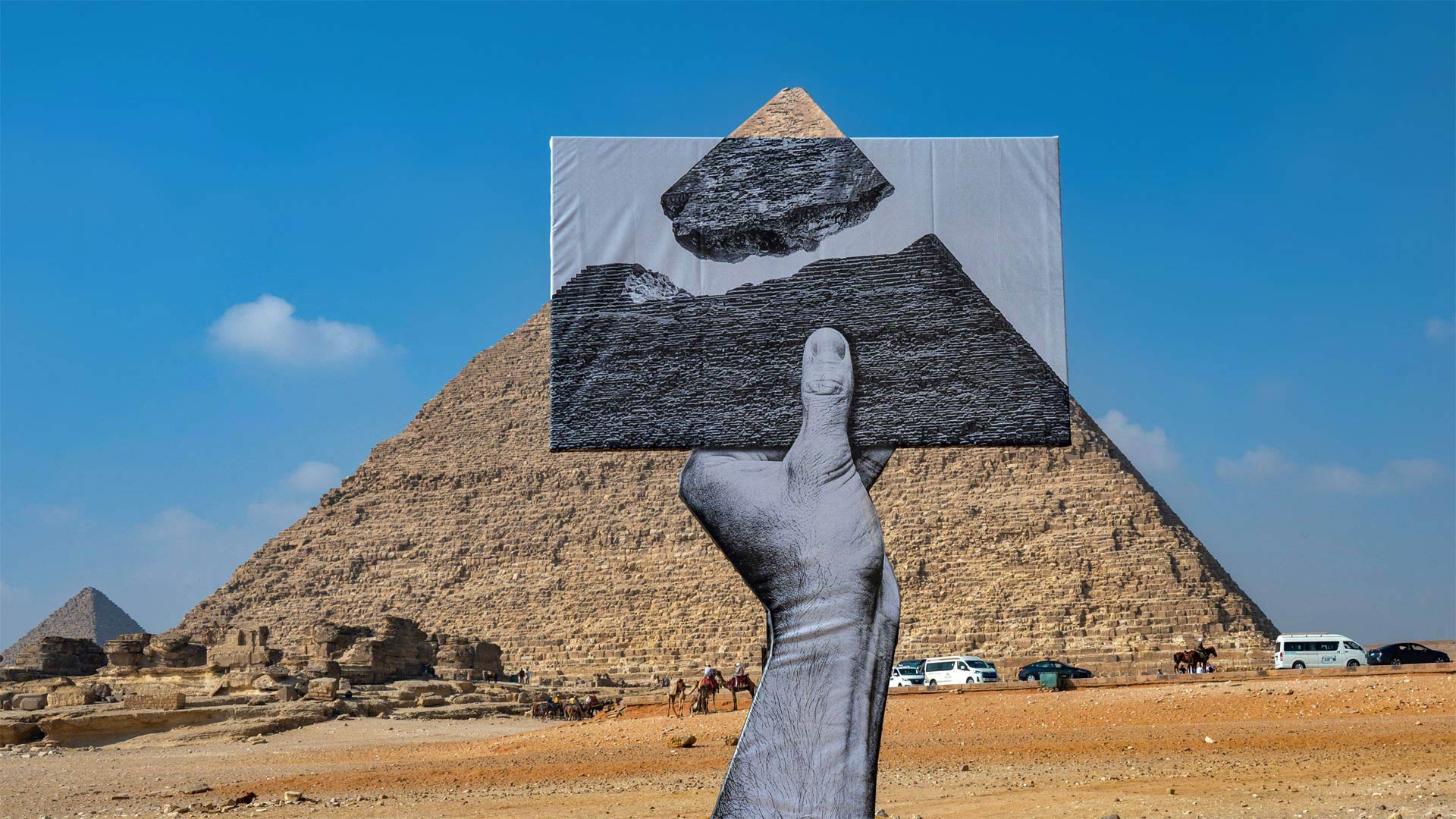
Jean Rene在埃及开罗创作的《吉萨的问候》 'Greetings From Giza' by Jean Rene, in Cairo, Egypt (© Ammar ABD RABBO/Abaca Press/Alamy)
今天不要让外表欺骗你 Don't let appearances fool you today
'Greetings from Giza' art installation by Jean Rene
In honor of April Fools' Day, take a moment to appreciate this trick of the eye created by French street artist and photographer Jean Rene, better known as JR. His cheeky public-art piece, installed in the desert sand as part of the 2021 'Forever is Now' exhibition, makes it look as if the detached tip of the Pyramid of Khafre magically hovers above its base.
Khafre is the second largest pyramid in the Giza complex, second to the Great Pyramid, whose capstone has been missing for all of modern history. (That's no joke.) The Great Pyramid's missing top has been the subject of much speculation and scholarly pursuit. This complex of pyramids was built around 2,600 to 2,500 BCE.
Visual illusions in art, a technique known as trompe l'oeil, is a specialty of JR, born in Paris in 1983 to a Tunisian mother. He always appears in public wearing a fedora and sunglasses, and has revealed very little of his identity. The enigmatic artist is most famous for making the glass-and-metal Louvre pyramid 'disappear.'
让·雷内的《吉萨的问候》艺术装置
为了纪念四月愚人节,花一点时间来欣赏法国街头艺术家和摄影师Jean Rene创造的这一奇观,他被称为小R。他那张厚颜无耻的公共艺术品,被安装在沙漠中,作为“2021永恒”展览的一部分,使它看起来像是哈夫雷金字塔的分离尖端奇迹般地悬浮在其基础之上。
卡夫雷是吉萨建筑群中第二大金字塔,仅次于大金字塔,大金字塔的顶石在现代历史上一直缺失。(这可不是开玩笑。)大金字塔缺失的顶部一直是许多猜测和学术研究的主题。这座金字塔群建于公元前2600年至2500年左右。
艺术中的视觉错觉是JR的特长,被称为trompe l'oeil,1983年出生于巴黎,母亲是突尼斯人。他总是戴着软呢帽和墨镜出现在公共场合,几乎没有透露自己的身份。这位神秘的艺术家以使玻璃和金属的卢浮宫金字塔“消失”而闻名。
哈特谢普苏特女王神庙鸟瞰图,埃及卢克索古城 Aerial view of the Temple of Hatshepsut near Luxor, Egypt (© Ratnakorn Piyasirisorost/Moment/Getty Images)
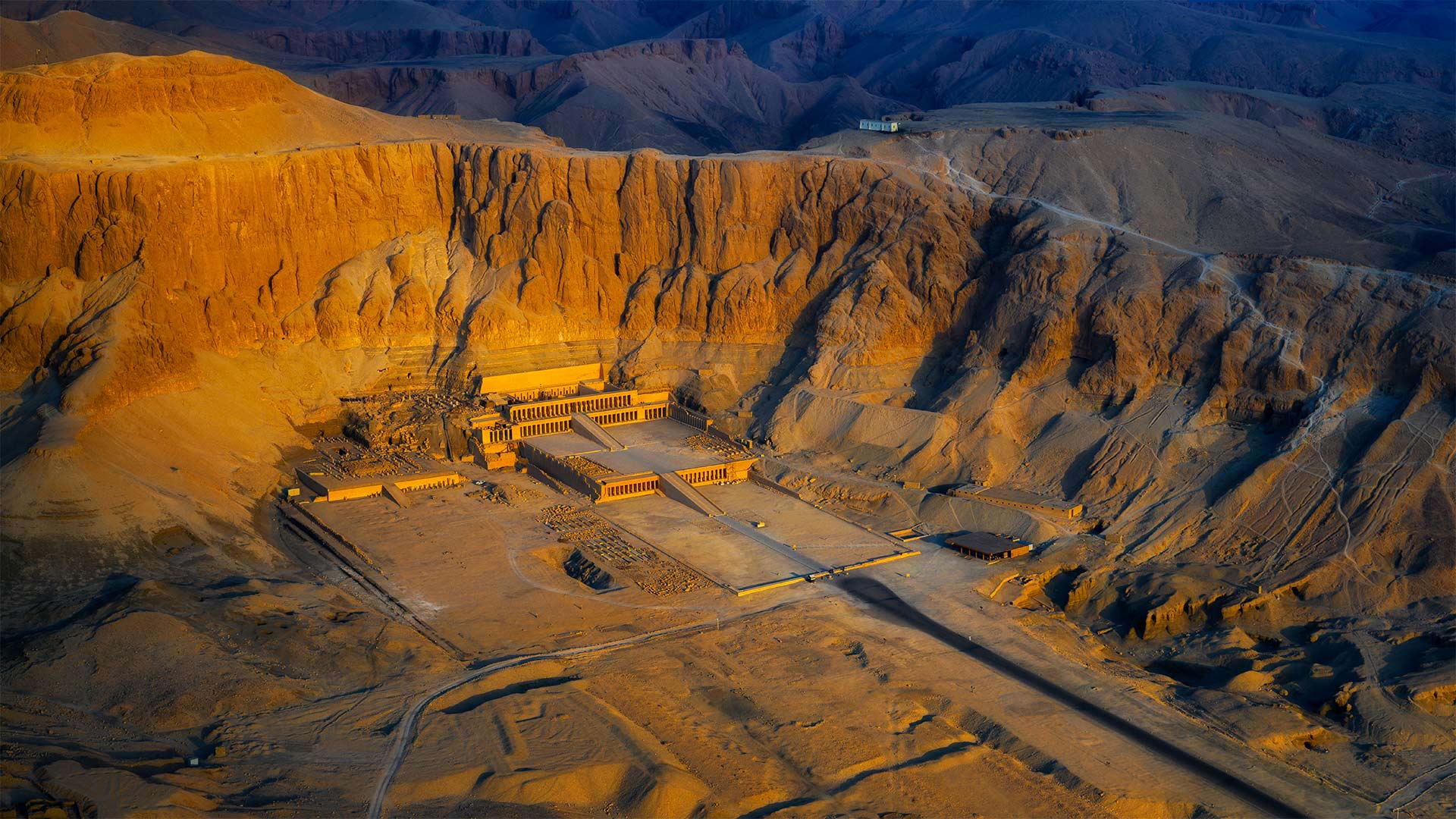
哈特谢普苏特女王神庙鸟瞰图,埃及卢克索古城 Aerial view of the Temple of Hatshepsut near Luxor, Egypt (© Ratnakorn Piyasirisorost/Moment/Getty Images)
Unearthing a queen's lost tale
Almost 3,500 years ago under Queen Hatshepsut's reign, Egypt enjoyed decades of peace and flourishing culture, and this elegant temple is just one piece of her larger-than-life legacy. But the pharaoh who succeeded Hatshepsut forbade all mention of her rule, taking credit for her monuments and leaving her name all but unknown for millennia.
By the 19th century, many archaeologists had noticed a gap in the recorded succession of pharaohs. Through their efforts decoding hieroglyphics, cataloging artifacts, and finally excavating Hatshepsut's great temple in 1906, the greatest woman ruler of her time began reclaiming her place in the history books.
Isn't it lucky we have people willing to dirty their hands and dig up the truth? On International Archaeology Day, which happens every third Saturday of October, we're celebrating those who solve human history's mysteries: the archaeologists of the past, present, and future.
发掘一个女王丢失的故事
大约3500年前,在哈特谢普苏特女王的统治下,埃及享有数十年的和平与繁荣的文化,而这座优雅的神庙只是她超越生命的遗产中的一部分。但是继承哈特谢普苏特的法老禁止任何人提及她的统治,因为她的纪念碑而受到赞扬,数千年来她的名字几乎无人知晓。
到了19世纪,许多考古学家已经注意到法老王的继承记录有一个缺口。通过对象形文字的解码,对文物进行编目,并最终在1906年挖掘哈特谢普苏特的大庙,这位当时最伟大的女统治者开始重新在历史书中占有一席之地。
我们有人愿意弄脏他们的手,挖掘真相,这不是很幸运吗?在每年十月的第三个星期六举行的国际考古学日,我们要庆祝那些解开人类历史之谜的人:过去、现在和未来的考古学家。
The interior of the Abu Simbel Great Temple in Egypt (© George Steinmetz/Getty Images)
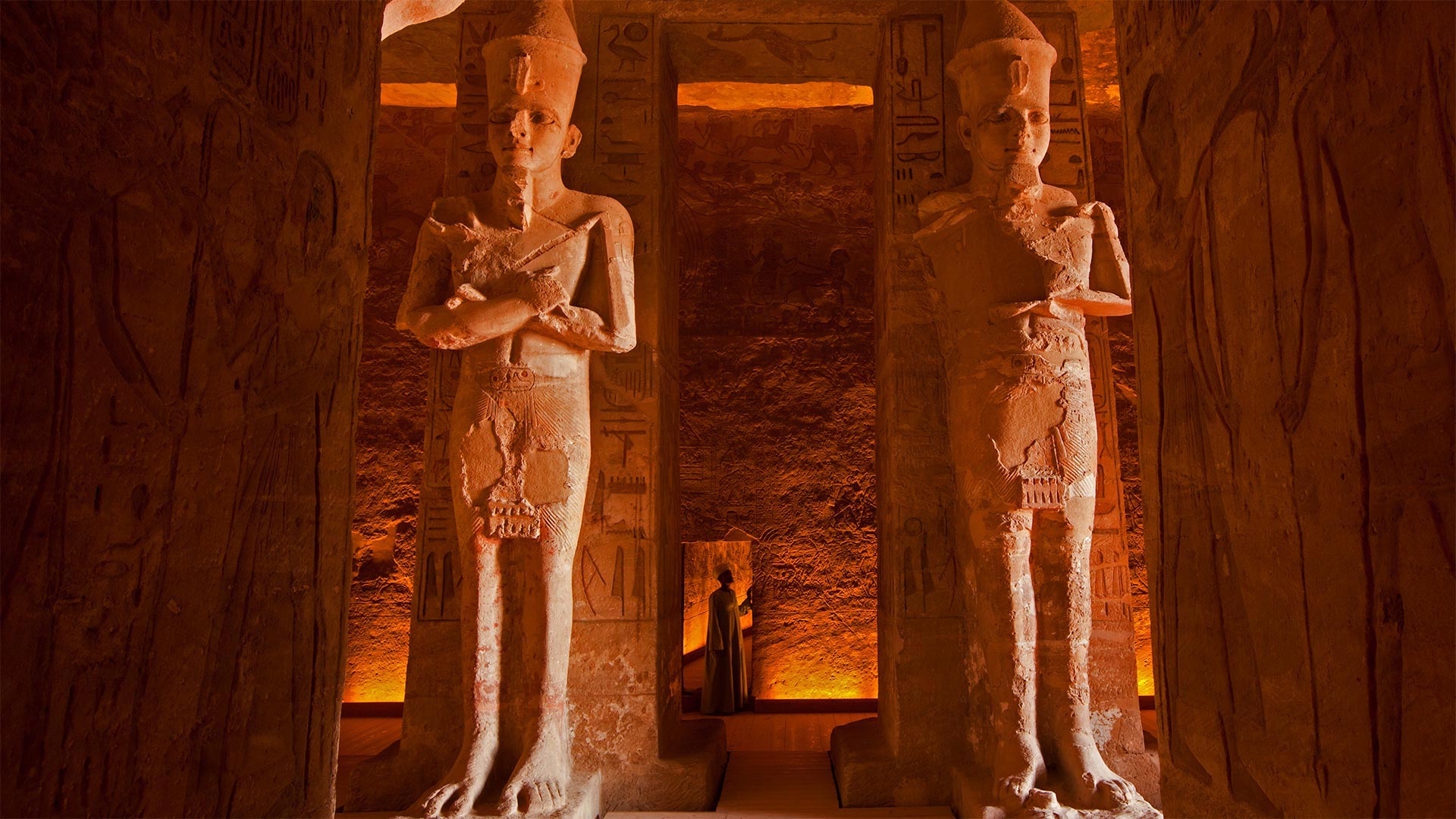
The interior of the Abu Simbel Great Temple in Egypt (© George Steinmetz/Getty Images)
A temple, preserved
These temples, commissioned by Egyptian pharaoh Ramesses II around 1264 BCE, would not be around for us to photograph if it weren't for the efforts of the United Nations Educational, Scientific and Cultural Organization (UNESCO). A couple centuries after the Abu Simbel temples were completed, Ramesses' empire had collapsed and the sands of the Nubian region of North Africa began to consume them. European explorers 'discovered' Abu Simbel in the early 1800s, leading to massive efforts to excavate and preserve the ruins of the great pharaoh's monument to himself.
But it wasn't until the 1950s, when the Egyptian government began drawing up plans for the Aswan High Dam, that preservation of Abu Simbel and other historic sites took on extra urgency. Planners knew the dam would flood the banks of the Nile, submerging the temples. So, the United Nations' UNESCO branch set to work on a solution to keep Abu Simbel preserved and accessible. In 1968, UNESCO's first major project was to literally move the massive temples to higher ground. They succeeded, of course, safeguarding one of the world's great archaeological sites. Out of this effort emerged UNESCO's drive to protect the world's most important sites of both cultural and natural heritage. To date, UNESCO has protected more than 1,000 World Heritage Sites across 167 countries that are ‘irreplaceable sources of life and inspiration.'
The interior of the Great Temple of Ramesses II, Abu Simbel, Egypt (© Nick Brundle Photography/Getty Images)
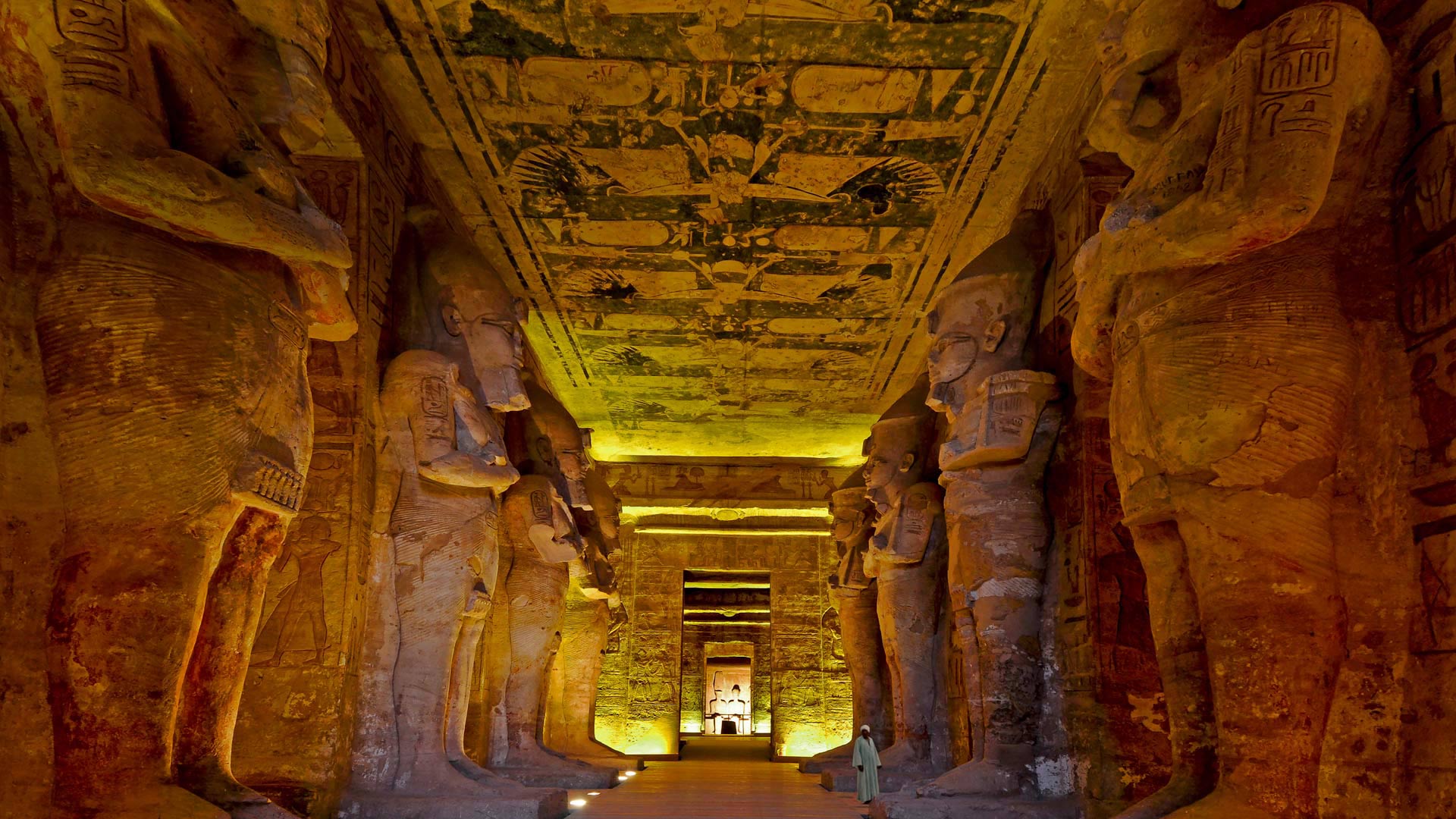
The interior of the Great Temple of Ramesses II, Abu Simbel, Egypt (© Nick Brundle Photography/Getty Images)
It's not always sunny in Abu Simbel…
This tiny lakeside settlement's Great Temple of Ramesses II was positioned on the orders of that powerful pharaoh so the inner sanctum (in this picture, that's the small room at the very back) is lit by the sun only twice a year. On February 22 and October 22 (thought to be Ramesses' coronation and birth dates, respectively), the first light of dawn illuminates the sanctuary and three statues within: one of Ramesses, one of the sun god Ra, and one of the chief god Amun. A fourth statue depicting the underworld figure Ptah is permanently shrouded in shadow.
The temple is one of a pair resting on the man-made Lake Nasser's shores, the other honoring the pharaoh's wife Nefertari. When the Nile was dammed to create the lake in the 1960s, the whole complex was painstakingly moved to higher ground. While it's unclear if the relocation slightly altered the original timing of the Great Temple's solar alignment, tourists still descend in droves on the site every six months to witness the luminous event.
Abu Simbel temples on the west shore of Lake Nasser, Egypt © George Steinmetz/Getty Images
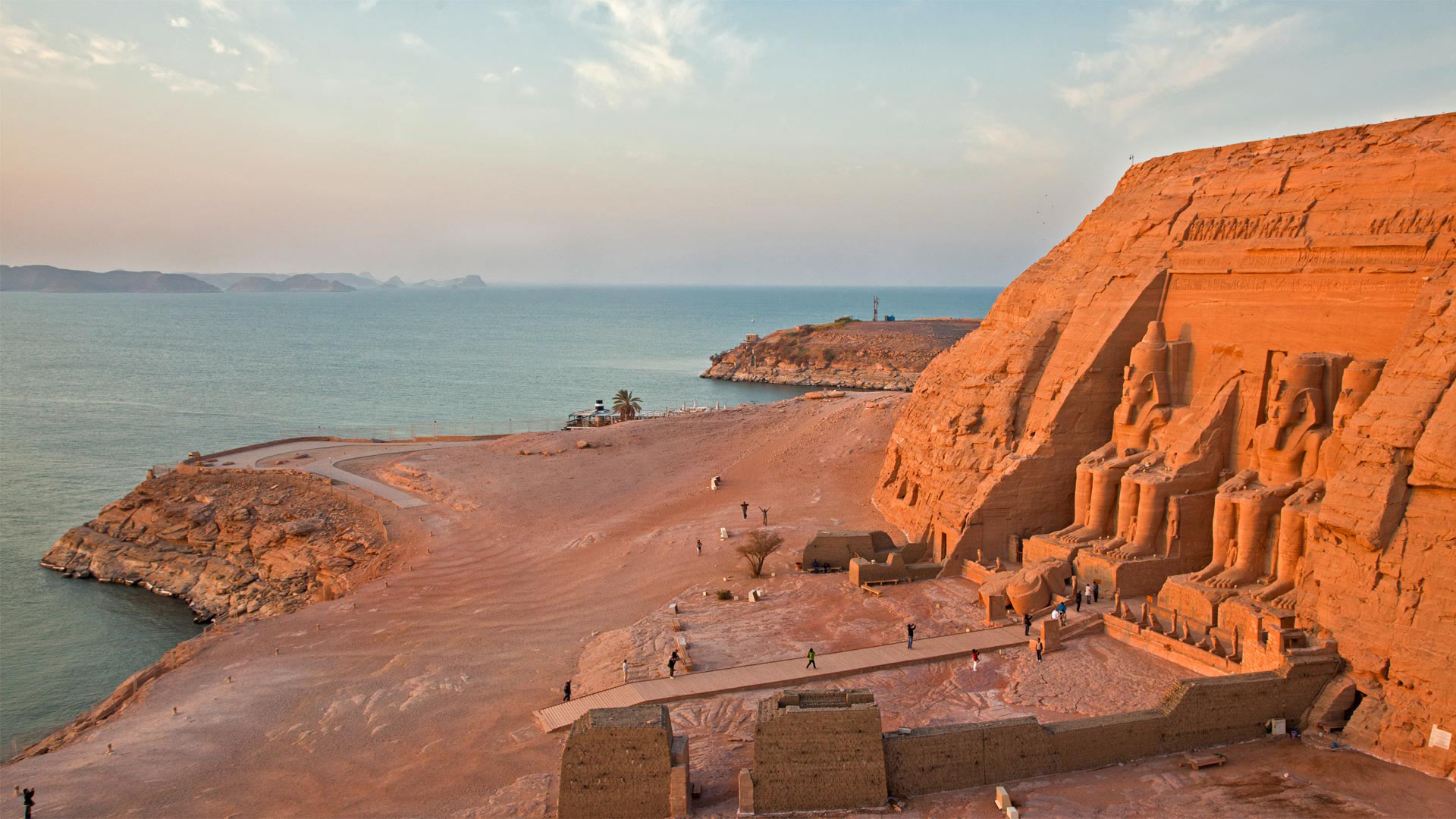
Abu Simbel temples on the west shore of Lake Nasser, Egypt © George Steinmetz/Getty Images
3,000 years of history
These massive temples - known today as Abu Simbel - were built in the 13th century BCE by the pharaoh Ramesses II. He left a legacy of monuments and temples across Egypt, many of which, like Abu Simbel, featured Ramesses II himself as the star attraction. But over the centuries, these temples were almost completely buried in sand and forgotten. It was not until the early 1800s when an explorer saw the heads of the colossal statues poking through the sand that the temples were again ‘discovered.’ Then, in the 20th century, rising waters of the Nile threatened to flood the site. The temples were disassembled and relocated to a nearby hill. The process took almost five years and required that workers cut the temples into pieces and reassemble them exactly as they were built 3,000 years ago. We think Ramesses II would approve.
